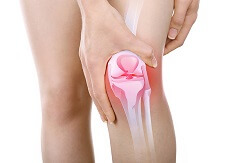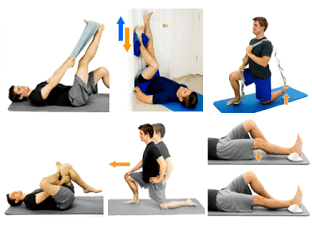Knee Rehab Exercises
Written By: Chloe Wilson, BSc(Hons) Physiotherapy
Reviewed by: KPE Medical Review Board

One of the key goals of knee rehab is building up muscle strength.
Having strong leg muscles provides better support for the knee, ensures that the forces going through the joint are evenly distributed, and helps reduce the pressure through the knee.
Virtually everyone suffering with knee pain, whatever the cause, will benefit from rehab exercises to strengthen their knee muscles.
Before embarking on these advanced knee rehab exercises, if you haven't already I suggest you start with the
basic
and
intermediate
strengthening exercises to build up your strength. The last thing you
want to do is overwork an already painful knee.
Start slowly and build up. Once you’ve mastered the first and second stage exercises, you are ready to progress onto these advanced strengthening knee rehab exercises.
Advanced Knee Rehab Exercises
The knee rehab exercises here will help to strengthen your quads, hamstrings, glutes and calves as well as improving your balance and stability.
1. Squats
Squats are one of the best ways to reduce knee pain and they strengthen the quads, hamstrings and glutes all at the same time.
- Stand upright with feet hip width apart, toes pointing forwards
- Slowly squat downwards as far as is
comfortable without letting your knees go forwards over your toes. Then
return to starting position
- Repeat 10-30x
- To work harder, increase the depth of the squat and/or hold at the bottom for a few seconds before coming back up
Top Tips: Don’t let your knees drop inwards, keep your kneecap in line with your second toe
2. Chair Squats
This is a great knee rehab exercise to increase knee strength in both the quads, hamstrings and glutes, again all at the same time.
- Stand on the leg to be worked, and put other leg behind you on a chair
- Slowly squat down as far as comfortable. The knee should not go beyond your toes (see dotted line). Return to starting position
- Repeat 10-30x on each leg
Top Tips: 1. Keep your back straight throughout – don’t lean forwards
2. The movement should be slow and controlled for maximum benefit.
3. Split Squats
This is a great knee rehab to increase quads, hamstring and buttock strength and improve knee control.
- Stand in staggered stance position (one foot in front of the other)
- Slowly squat downwards taking your back knee towards the floor. Then slowly return to starting position
- Repeat 10-30x on each leg
- For more of a challenge, start with your front leg up on a step (as shown). This allows you to squat even lower!
Top Tips: 1. Make sure you are going down not forwards
2. The emphasis should be on a slow, controlled movement
3. Don’t let your front knee go forwards over your toes
4. Lunges
Lunges are a great knee rehab exercise to increase knee strength and control. They are similar to squats but require more control as you step forwards and lower at the same time making them more functional.

- Start by standing upright, feet pointing forwards
- Step forward with one leg and drop your back
knee, keeping most of your body weight on your front leg. Push off the
front leg to return to standing position
- Repeat 10-30x on each leg
- You can challenge yourself further by stepping forwards onto a box as shown to increase the depth of the dip and/or holding weights while doing the exercise
Top Tips: 1. Keep your toes pointing forwards and your back straight
2. Don’t let your front knee go over your toes – if that is happening you need to step further forwards
5. Lunge Clock
This is a great way to increase knee strength and control. It gets you moving in all different directions making it really functional.
- Stand upright, feet pointing forwards. Imagine you are at the centre of a clock
- Step straight forwards as if to 12 o’clock with one leg and drop your back knee, keeping most of your body weight
on your front leg. Push off the front leg to return to starting position
- The lunge slightly to the side, as if to 1 o’clock and back.
Then to 2 o’clock etc until you have worked your way all round the
clock
- Repeat 5-10x on each leg
- For more of a challenge, hold weights while doing the exercise
Top Tips: 1. Keep your toes pointing forwards and your back straight
2. Don’t let your front knee go over your toes – if that is happening you need to step further forwards
6. Plank Leg Lift
Plank leg lifts are a great way to increase buttock and leg strength and control.
- Lie on the floor with your hands directly under your shoulders
- Tighten your abdominal muscles and lift
yourself up off the floor, keeping your body straight. Then lift 1 leg
up off the floor
- Hold for 3 seconds a lower
- Repeat 10-20x on each leg
- For more of a challenge you can also pulse your leg up and down quickly in this position to further strengthen the muscles
Top Tips: 1. Keep your back straight – don’t let it arch up or sink down
2. Keep your pelvis/hips level – don’t let them drop down on one side
7. Box Jump
Box jumps are a useful part of knee rehab to increase knee strength and control. They are particularly good after ligament injuries e.g. ACL injuries
- Stand upright next to a small, sturdy box/step
- Jump up sideways onto the box, landing with both feet. Then jump off the box down to the ground, again landing with both feet
- Repeat 10-30x each way
- Progress to jumping completely over the box landing with both feet together on the far side
Top Tips: 1. Make sure the box is sitting securely so it can’t move when you jump onto it
2. Start with a low box/step and gradually increase the height
Remember, with any knee problem, you should always see your doctor before you start any knee rehab, but once you get the all clear, you’re ready to begin. To get the most out of these knee rehab exercises, visit the Top Tips on Exercising section before you start.
What Next?
You want to gradually increase the number of repetitions you are doing of each knee rehab exercise as suggested.
When trying to increase muscle strength, you should do exercises at least five times a week. If you’re only doing them once or twice, they won’t make much of a difference. And you must persevere. It can take a good six months to really build up the strength of muscles.
Once you are up to the maximum suggested number, you should have really good strength in your leg muscles, and your knee should be feeling much better – CONGRATULATIONS! Your hard work with knee rehab has paid off.
You can now cut down to doing the knee rehab exercises three a week to maintain that strength. Make sure you are also keeping up with knee stretches too!
Page Last Updated: 11/09/21
Next Review Due: 11/09/23











